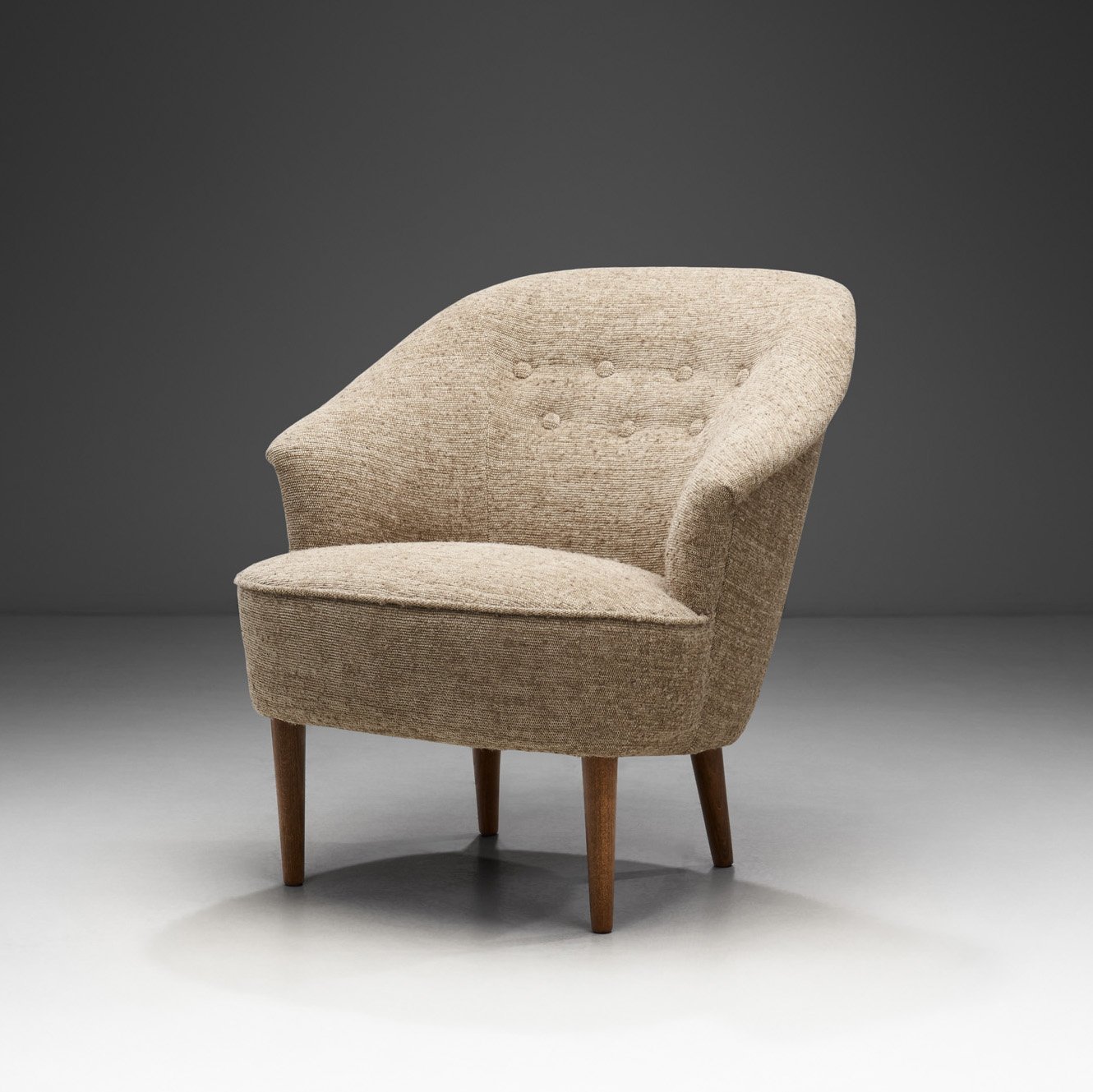CARL MALMSTEN
Carl Malmsten was born on December 7, 1888 in Stockholm, Sweden as the son of Karl Malmsten and Inez Cadier. He was a Swedish furniture designer, architect, and educator, who was known for his devotion to traditional Swedish craftmanship (slöjd) and his opposition to functionalism.
Malmsten’s career started in 1915, when the results of a furniture competition for the massive new building project, the Stockholm City Hall, were announced. The surprised jury realised that they had awarded both first and second prize to a hitherto unknown designer. This was to change very soon. The interior of the Council Chamber and other meeting rooms in the City Call became a great break-through for Carl Malmsten, and the furniture is still used by the City Council. Oddly enough, the beautiful writing chair with which he won the competition, never found a place in the building. Shortly after in 1917, he already exhibited alongside well-known Swedish architects such as Gunnar Asplund and Uno Åhrén.
By the 1920s, Carl Malmsten became one of the most sought-after interior and furniture designers in all of Sweden. Prestigious commissions were rolling in. Most famously, he was invited to furnish a room for the crown prince, Gustaf VI Adolf, and his wife Lady Louise Mountbatten in Ulriksdal Palace as a wedding gift. The architect Ivar Tengbom engaged him for the Stockholm Concert Hall, Ivar Kreuger’s Matchstick Palace and the Swedish Institute in Rome. Waldorf Astoria in New York phoned and asked Carl Malmsten to make the furnishings and furniture for their bedrooms, salons and dining rooms. In banks, insurance companies, the Riksdag – as soon as luxurious board rooms were required, Malmsten’s name was quickly mentioned.
Already as a young designer in the early 20th century, Carl Malmsten advocated an artisanal way of furniture design based on local materials and traditions, available to a wide audience at a reasonable price. In connection with the Stockholm Exhibition in 1930, Malmsten took a stand against the sterile varieties of functionalism. In return, he was accused of being a narrow-minded apostle of handicrafts, disregarding the great production factor of the time: industry. It was not until after the war that Malmsten started combining handicraft and industry in his work. Up until then, the furniture had been made at the school he started in 1930 and at a number of joinery workshops suited to artisanal production. He established contact with a group of high-quality small industries, the so-called Key Workshops. Some of these original Key Workshops still make classic Malmsten designs, for example, Stolab in Smålandsstenar, where Lilla Åland and Vardags are made, and O. H. Sjögren in Tranås, where upholstered armchairs such as Rundrygg, Farmor, Hemmakväll and Samsas are created. Just like Josef Frank and Svenskt Tenn, Carl Malmsten represents a distinct style of interior design that lives on long after its creator has passed away.
The breakthrough came in 1956, with an exhibition at the Röhsska Museum of Design and Craft in Gothenburg, where for the first time, Malmsten showed furniture designed for serial production, which soon found their way into the Swedish “People’s Homes”. Nature was Carl Malmsten's foremost teacher and source of inspiration. He conveyed his love of craftsmanship as a teacher in his own schools, at Olofskolan in Stockholm, Capellagården on Öland and the Carl Malmsten school on Lidingö, today a branch of Linköping University and one of the country's leading design colleges, simply referred to as “Malmstens“, where the basic philosophy is still that hand and mind must engage in creative collaboration. He had a tremendous sense of proportion and designed furniture that people would feel very much at home with – and comfortable in. “Neither light, nor eyes or people like bumping into sharp corners”, he explained. Therefore, all edges had to be smoothed so that they were kinder to the eye and to the touch.
Malmsten has had a lasting influence on Swedish furniture design through the two schools he founded. His furniture was in many ways a product of the thoughts and ideals of the time, possessing a timeless quality that makes them just as relevant and loved today. Malmsten never stopped creating, never stopped working. Until his death in 1972, he was the head of his company and schools, still planning exhibitions and was busy designing new pieces of furniture carrying a strong tradition into the future.
Carl Malmsten devoted his life to the renewal of traditional Swedish craftsmanship, inspired by the cultural examples of the Swedish country manor and rustic styles – furniture endowed with a creative simplicity, with a feeling for the wood itself, with function in mind and a high technical quality. Malmsten’s light wooden furniture, with their blonde range of colours, have in themselves become an allegory for that which is typically Swedish, with strong references to Swedish nature and cultural traditions. As a furniture maker he expressed the old, inherited forms as well as the new, bold ideas with his language of design. The result will forever be the same - beautiful, eternal individual pieces of furniture which together create a unified and harmonious feeling.
Interesting literature:
Inspiration och Förnyelse: Carl Malmsten 100 År (Swedish and English Edition) by Elisabet Stavenow-Hidemark (Author), Nordiska Museet (Author), Ord Bildarna (Author), Carl Malmstens verkstadsskola (Author), Carl Malmsten (Illustrator), Wiken 1988




















